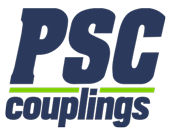Couplings Must First Satisfy Three Conditions
- Torque: Define the Torque value for Maximum Continuous Torque (MCT) and Peak Torque (POT) —
- Torque [lb-in] = (HP)(63,025)/(RPM)
- Bore Capacity: Hub Bore Capacity is defined by catalog values.
- Length: Minimum Length is defined by catalog values; Maximum Length is limited by manufacturing processes and critical speed.
Hub Bore Specifications for Bore, Keyway, and Setscrews
- The default/standard hub bore for PSC Flexible Disc Couplings is to use an interference fit with one keyway with no set screw over the keyway.
Hub Bore Diameter
- Hub bore diameter dimensions are specified to match the shaft of the equipment on which the hub is mounted. Defining the bore dimensions can appear confusing to a person who is unfamiliar with the specifications, and it is made more complex by adding options for different fits (interference, transition, or clearance) between the shaft and hub.
- ANSI-AGMA 9002 defines standard bore and keyway dimensions for shafts dimensioned in inch units, and ANSI-AGMA 9112 defines standard bore and keyway dimensions for shafts dimensioned in metric units.
- Keyless hubs are often specified for high speed applications to improve the balance of the assembly and to secure the hub to the shaft. In these cases, the magnitude of interference is increased by reducing the hub bore diameter. PSC engineers will calculate the interference required to handle the specified torque and analyze the hub stress and hub material to ensure adequate strength.
Keyways
- Keyway dimensions are specified in ANSI-AGMA 9002 for shafts dimensioned in inch units, and ANSI-AGMA 9112 for shafts dimensioned in metric units.
- Customers may specify a key size that is one size larger or smaller than the standard size specified by the ANSI-AGMA specifications. Alternatively, a custom keyway with nonstandard dimensions may be specified, but this would require a more expensive EDM process to machine the keyway.
- Two keyways may be specified by the customer. A second keyway is generally positioned at 90° to the first keyway; 120° or 180° are also common.
Set Screws
- Set screws may be positioned over the keyway. Customers may add a second set screw which is generally positioned at 90° to the keyway; 120° or 180° are also common. The length of the set screw will be selected to closely match the length of the thread in the hub to improve the balance of the assembly.
